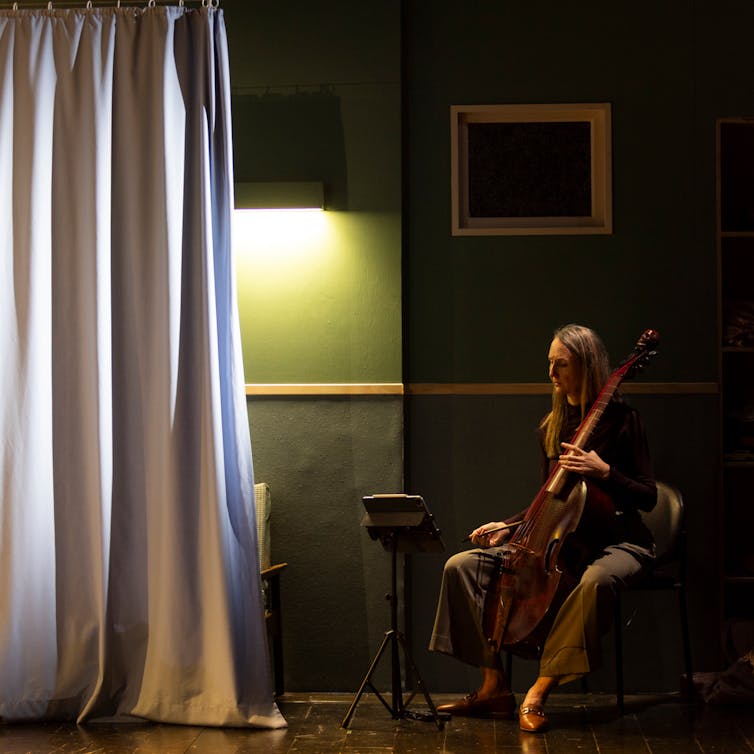
In The Spare Room, Judy Davis lights up the stage with a singularly vivid performance.
Adapted by Eamon Flack from Helen Garner’s 2008 novel of the same name, Davis plays sharp-tongued Helen (or Hel) to the irrational Nicola (Elizabeth Alexander), who visits seeking alternative treatments for her cancer-ridden body.
But unfortunately, the production does not match Davis’ star performance.
A shaky reality
Set and costume, by Mel Page, echo Garner tropes: bed linen, windows, back door onto shared backyard with family as neighbours, curtains, lounge, kitchen, vodka, music, bicycle and miniature pink backpack.
But I’m increasingly unable to suspend belief in stage designs whose purpose is to mimic reality. A curtain is used inconsistently to indicate a change of space. The kitchen table is appropriated for medical professionals’ desks and magician’s table without any change of lighting or further demarcation of space and time.
Kitchens and cooking are important to Garner’s domestic settings. There’s a brief smashing of apricot kernels. Bananas, licorice bullets and lemonade get a mention. But Hel’s chopping of a limp celery comes out of nowhere, and means very little.

If the adaptation is going to use food, meal preparation and cooking, then use it substantially as a motif.
For time changes, Hel yells out the day. The pace is speedy, with Davis firing off dialogue and scampering across stage. We get no sense of the dragging time that Hel experiences as carer.
The same actors playing multiple characters without much change of physical appearance lacks credulity. Nicola, in particular, is presented as a cliché of an older, suburban woman – not Garner’s wealthy bohemian. Nicola is based on Jenya Osborne – a friend of Garner and her third husband, Murray Bail, who described Osborne as “alternative virtually everything”.
Garner is the queen of sustained metaphor. In the novel, a broken mirror and a creature scuttling in dried leaves are early images of death.
In Flack’s adaptation, the mirror is only spoken of, accompanied by a strum across the cello by Anthea Cottee (music composed by Steve Francis).

There may have been a flourish of flamenco on the cello as Hel prances in imitation of the liveliness of her granddaughter, Bess (who is only referred to once), but it is too unimpactful to recall.
At one point, Hel plays on a toy piano accompanying the cello, a comedic reference to Garner’s most acclaimed novel The Children’s Bach (1984).
On death and dying
The clearest image of dying and death is central in the play: a magician’s show that Hel has to review. “The most beautiful things happen secretly and privately”, the magician (Alan Dukes) says, as he whisks away then recovers various objects.
A failure of both Garner’s book and the stage adaptation is that Hel complains of exhaustion after only a few weeks caring for Nicola. But many people spend years caring for a sick loved one, giving up another possible trajectory of their own lives.

The balance is wrong, too, between the humanity of Hel and Nicola: the audience guffawed at Hel’s exasperated wit and Nicola’s investment in fraudulent therapies. This, perhaps, is a feature of Garner’s work. While Garner is self-critical in her writing, she also consistently exposes others.
Bail is critical of Garner’s use of their friend’s life as fodder for a novel. He writes:
[Osbourne] was all kindness and consideration, which was rewarded as she was dying by being portrayed in [Garner’s book], where her harmless foolishness was pitied and scorned.
In Garner’s novel, Nicola and Hel “[dissect] with cheerful meanness the latest escapades” of her ex-husband. But in the play, Hel recounts her acts of revenge against him in their Sydney flat, drawing on Garner’s third diary, How to End a Story: Diaries 1995–1998, published in 2021. Bail is not named in either play or novel, but fans of Garner’s work know of whom she speaks.
The play is part monologue by Davis. Monologues and choruses effectively give oversight and insight to the narrative, but here it only further spotlights Hel’s story, not Nicola’s who is the one dying in pain.
With some details in the dialogue of Nicola’s dying processes – and with her plan to take an entourage for residency in an expensive hotel – Hel then “handed her over”.
As the play opens with a reference to the life-filled antics of Hel’s granddaughter, we know that the granddaughter, now assumed to be recovered from a cold, can be handed over to her. It is a rational ending, but lacking vitality.
The Spare Room is at Belvoir, Sydney, until July 13.
Moya Costello does not work for, consult, own shares in or receive funding from any company or organisation that would benefit from this article, and has disclosed no relevant affiliations beyond their academic appointment.
This article was originally published on The Conversation. Read the original article.







